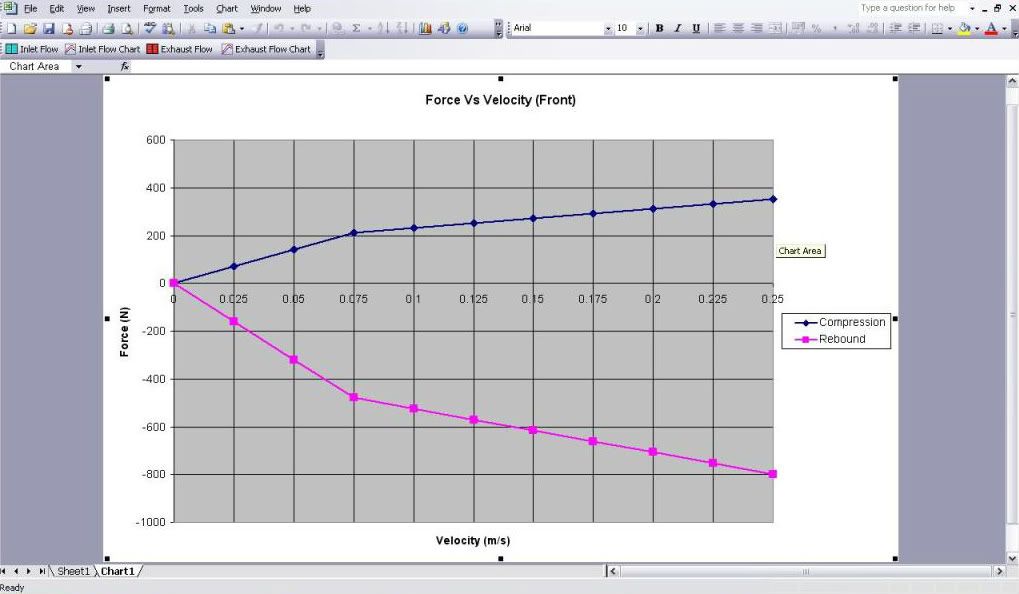
Suspension Settings
#1

Posted 10 March 2012 - 04:54 PM
#2

Posted 10 March 2012 - 06:59 PM
#3

Posted 11 March 2012 - 09:28 AM
So after 21/2 year of driving he car and getting used to it thought I'd check what settings my Nitron's have. A bit surprised to find 22 clicks from hard front and 18 rear, and I thought it was bit harsh on the road!
Set them to 10 from hard front and 12 rear, should improve things on track
Not sure what it will be like on the road, been for a blast an feels good - still harsh for road though but not much point going softer as far as my experience goes.
I think shocks are due a refurb - will this improve the feeling on the road?
These can test your dampers on a damper dyno and tell you if they need a refurb:
http://www.blinkmotorsport.com/
#4

Posted 15 March 2012 - 02:21 AM
(1) This is going to be quite a lengthy post that is going to need some concentration to fully understand!
(2) I'm sorry if I'm teaching the technically minded to 'suck eggs'.
Question from the OP:
My Nitron shocks feel harsh even when set soft - do they need a re-build?
Let me explain my position - we regularly test 'shocks' (correct term is dampers) on our Damper Dyno and offer advice on their valving/suitability/settings to customers.
It is possible to mathamatically calculate what the valving of a damper should be to get you in the right 'ball park' for the type of use you wish to use the vehicle for.
The next question is:
How do we select the right valving for the damper?
Firstly we have to select the right springs with which to 'suspend' our cars on. We do this by selecting a 'Bounce Frequency' - the lower the Bounce Frequency the more comfortable a car will feel and the more mechanical grip it will have but it will feel unresponsive to driver input.
Typical frequencies are:
0.2-0.3 = Comfortable road cars
0.45-0.6 = Track cars
0.7-0.8 = Race cars
The bounce frequency is usually set different Front to Rear by a small margin; in a passenger car the front of the car hits the bump before the rear so the rear needs a higher frequency than the front to 'catch up'. (race cars are different as comfort isn't an issue!).
Once we have a target 'Bounce Frequency' we can use formulas to calculate our spring rates using the sprung and unsprung mass supported by that wheel and the motion ratio of the spring (angle it's inclined at in simplistic terms).
This then allows us to select the correct springs for that vehicle.
Now that the springs have been selected we can look at what damping is required to control that spring.
The first consideration we need to take into account is 'The Damping Ratio'.
The Damping Ratio
Critical damping - when a spring is 'un damped' and it is compressed it will continue to cycle as it is released, critical damping is when the spring is damped to a point when it returns to it's fully open length in the shortest time possible without any overshoot; this is said to be a damping ratio = 1.
This initially seems desireable but the problem occurs when you 'hit' a series of small bumps such as the kerbing on a race track; the suspension 'jacks up' and you end up running on the bump stops as the spring can not return to it's open length quickly enough.
The lower the damping ratio the more comfortable the car will feel but again the more 'sloppy' it will also feel.
The following are common damping ratio's:
2-3 = Comfortable road cars
4.5-6 = Track cars
7-8 = Race Cars
OK, now we have selected our target damping ratio we can now use it to equate our damper characteristics.
The Infamous Force Vs Velocity Graph
Some people may have seen these with the set of dampers they have been sold - most of them produced and sold with the dampers by the manufacturers are 'generic' and bear little resemblance to what you have in your boxes!
What is the Force Vs Velocity damping Graph?
This graph has nothing to do with the speed of your car! The velocity part relates to the shaft velocity of the damper itself. A damper works by flowing oil through orrifices with 'shimstacks' controlling the flow of oil as well. The faster the shaft of the damper moves the more force it will generate.
A typical Forve Vs Velocity Graph is Shown below:

Lets examine the axis:
Velocity ; This axis is split into two areas; the low speed damping (Below 0.075m/s) and the high speed area. The low speed damping is what the driver feels when he turns the steering wheel or brakes/accelerates. As you turn into a corner the loaded wheel compresses and the unloaded wheel extends; the damper rod moves relatively slowly during these events.
The high speed area is when you hit a pot hole or a bump - the damper shaft moves very quickly under these circumstances.
Force; The graph is shown with the compression damping as positive and the rebound as negative. A daper works both in compression (as the rod is pushed into the damper body) and in rebound (as the rod is pulled from the damper body).
How do we choose a 'curve' for our Force Vs Velocity Graph?
If its a Track Day car driven to the Circuit we would be aiming for a damping ratio of, lets say 0.7 - this ratio can be entered into an equation to obtain an initial 'slope' for our damper graph.
We then need to modify our graph for intended use; The purpose of the damper is to control the spring. When the spring is being compressed energy is being stored in the spring, when it is released the damper needs to control it's release - hence we normally have more rebound force than compression force on the damper curve.
(Compression damping is said to control the unsprung mass whilst rebound damping controls the sprung mass).
The last part is tuning the high speed area; we want the low speed to 'feel' good - hence the damping ratio of 0.7 but we might want the high speed to feel comfortable and 'trade off' some performance, therefore we might choose a damping ratio of 0.3 for the high speed damping.
This is why you will get two different gradients of lines on the damper curve in both rebound and compression.
The shape the curve makes are also given different names:
(1) Progressive (as Shaft speed increases so does damping rate)
(2) Linear (As shaft speed increases damping rate remains constant)
(3) Digressive (as shaft speed increases damping rate decreases)
Therefore for a race shock we may well look at a Linear damper and for a Sports shock a Digressive damper curve may be more suitable - offering both 'feel' at the 'low speed end' and comfort at the 'high speed end'.
So, Back to the OP's question at last!
I'll make no bones about it - Nitron Dampers are some of the highest quality dampers we see on our dyno!
The problem is - they are designed as a 'racing shock' and offer very little compromise towards comfort over outright performance. Everything in suspension is a compromise and this is what you choose with Nitron IMO.
Lets look at a 'real World' (CVP) dyno plot of an Elise Nitron Damper from our damper dyno; this was produced 5 clicks from the softest setting:
(This graph shows both RO & CC + CO & RC
- for an explanation of these terms see the further reading below)

As you can see; the Damper acts in a fairly digressive way in compression and linear in rebound - this is why the car will feel harsh over bumps and pot holes whilst driven on the public roads no matter how 'soft' you have them set (High speed damping ratio remains high) but will provide superb control on the race track both in 'feel' to driver input whilst turning and traction whilst running over curbing.
Whole books have been written on the above subject and it is an extremely complex subject - I have omitted numerous items to keep it as simple as possible in the hope that some of the forum users that weren't aware of this subject have managed to get this far!
For further reading on how Damper Dyno curves are generated and what they mean please look at the following link:
http://www.roehrigen...tion%20page.htm
HTH,
Please do not hesitate to email us if you have any questions.
Edited by techieboy, 15 March 2012 - 08:16 AM.
#5

Posted 15 March 2012 - 08:23 AM
The following are common damping ratio's:
2-3 = Comfortable road cars
4.5-6 = Track cars
7-8 = Race Cars
Sould Read
0.2-0.3 = Passenger Cars
0.45-0.6 = Track Cars
0.7-0.8 = Race Cars
(Added this edit before but it's dissapeared and can not edit original post???)
#6

Posted 15 March 2012 - 08:24 AM
#7

Posted 15 March 2012 - 08:34 AM
I edited the original for you and removed it!
Sorry.
#8

Posted 15 March 2012 - 09:39 AM
#9

Posted 15 March 2012 - 09:45 AM
#10

Posted 15 March 2012 - 11:25 AM
#11

Posted 15 March 2012 - 11:53 AM
#12

Posted 15 March 2012 - 01:15 PM
#13

Posted 15 March 2012 - 07:10 PM
Wow I wasn't expecting that level of answer, only posted original as I was a bit shocked to find the settings I'd been running around on for 30 months! There is a lot of talk on here about what setting to have and it appears it does not matter that much in fact - well not until you are well beyond my level of driving ability and the car set up is slowing you down!
The only reason I think they may need a refurb is because they were fitted by the first owner early on in the cars life and it's now on 85,000 miles. The Nitrons are looking a bit scruffy which is another reason to get them done.
Sounds as though they could benefit from a once over, especially if you don't know their history.
If you want me to speak to Nitron on your behalf I can. They do a refurb service for £65+vat per shock plus any parts required (outside of the normal service parts).
#14

Posted 15 March 2012 - 07:22 PM
#15

Posted 15 March 2012 - 07:23 PM
I edited the original for you and removed it!
Unfortunately, I've just noticed the wrong part has been edited!
The Bounce frequency was the part that has been edited and now reads incorrectly - just to make things clear:
Bounce frequencies when choosing springs are:
0.5 - 1 Hz = Comfortable passenger car
1.5 - 2.5 Hz = sports/Race Car
3.0- 5.0+ Hz = Aero Cars
Damping Ratio's when selecting damper Valving should read:
0.2-0.3 = comfortable passenger car
0.45-0.6 = Track car
0.7-0.8 = Race Car
Hope this helps
#16

Posted 24 March 2012 - 02:42 PM
1 user(s) are reading this topic
0 members, 1 guests, 0 anonymous users


















